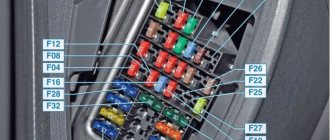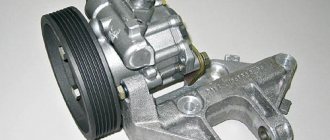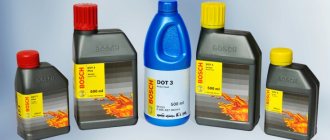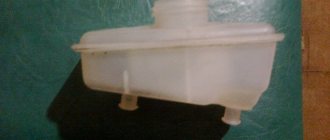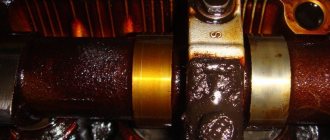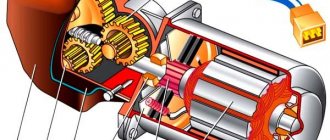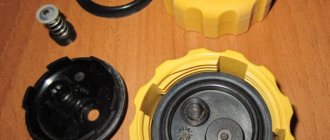This article describes a method for independently checking the fluid level in the power steering reservoir.
The power steering reservoir is one of the important components of the power steering. When the car engine is turned on, the pump starts working, pumping fluid from the power steering reservoir and dispersing it throughout the sealed steering system. This creates pressure in the power steering, which allows you to rotate the steering wheel without any effort on any type of car. And here, it is necessary to monitor the fluid level in the tank, since the normal functioning of the entire steering system depends on it.
When to change the power steering fluid
When you take your car to a service station, you may often hear that you need to flush the power steering pump and fill it with fresh fluid because the fluid that is leaking has become dark. Keep in mind that motor oil and transmission fluid also become darker over time, so a darker shade of red does not mean your power steering fluid is bad.
But still, how often should you measure and check the power steering fluid? There are a few simple rules that can be applied to answer this question. The simplest thing is to change the oil and filter every 12 months at a minimum. Completely flush out the old oil from the reservoir and install a new filter.
It is also very important that the oil and filter are changed whenever the hydraulic circuit breaks. What do we mean? Every time a component is removed and replaced, if the oil and filter are not replaced, the dirty oil will damage the new/refurbished components, reducing their lifespan significantly.
Use gloves to limit skin contact and safety glasses. Dispose of used power steering fluid at any recycling center that accepts automotive oil or hazardous materials.
More details about replacing (flushing) the power steering below:
- First, check your car's owner's manual or repair manual for specific fluid that can be used in your power steering. You need to use power steering fluid or automatic transmission fluid (ATF) that meets the manufacturer's specifications.
- Locate the power steering fluid reservoir or power steering pump located with the engine accessories. Look for a cap with a steering wheel symbol or that says "Power Power Fluid Only." Remove the cover.
- Use a jack to raise the front of the car until the front wheels are off the ground.
- Wearing gloves, pour the liquid from the reservoir into a specially prepared container, using a pump to transfer the liquid. If you will use a hose, it is better to buy an inexpensive hose that will serve specifically for such tasks.
- As soon as the fluid level in the reservoir becomes too low to drain effectively, turn on the engine. This will allow the steering wheel to rotate but will not activate the steering pump. Turn the wheel lock to lock (all the way to the left, then all the way to the right) and the pump will push more dirty fluid into the reservoir. Pump it out into your bad fluid reservoir.
- Repeat step 5 until there is no liquid left in the reservoir to remove. Use dry wipes (or disposable towels) to remove any drips that occur while pumping out the fluid.
- Optional: To completely drain the fluid (flushing the power steering fluid), sit under the car and locate the rubber hose connected to the power steering pump. Use pliers to remove the clamp, pull down the hose and allow the rest of the liquid to drain into the container. This can be a very messy procedure, so keep some tissues nearby.
- Place a funnel into the opening of the power steering reservoir.
- Pour new fluid into the power steering. Use only as much fluid as the owner's manual recommends and be careful not to overfill as excess fluid will leak out while driving. Optional : Add recommended amount of power steering conditioner/stop leak. This extra step will ensure the pump runs quietly.
- Replace the cover and turn on the engine. Turn the wheel lock to lock again. Check the fluid, add if necessary. You may see some bubbles in this step. It's just air coming from the system. This is a good sign; Unlike brake fluid, power steering lines do not need to be bled to remove air bubbles.
- Lower the jack. Place the car on your wheels.
- Restart the engine and let it run for about 15 seconds while turning the steering wheel again. Check the fluid level to ensure that air has left the system and the fluid remains at the correct level.
- After filling the reservoir, drive around for five minutes, making several full turns on both sides of the car's steering wheel. Check the fluid one last time. If you are at the "Full Hot" line on the dipstick, you may be done with the replacement. Be sure to check for leaks after a day or two.
More details in the video:
on “Power steering - its design, maintenance and repair.”
- Georgy:
The power steering designers should be thanked. Driving has really improved; I can turn the steering wheel with one finger. However, you should remember that power steering is a complex mechanism that requires due attention. The first thing you need to do is take care of the belt. It should not look worn out or weakened. When the belt is reverberated, it produces a characteristic whistle. You can tighten the belt yourself. Since the power steering fluid also performs a lubricating function, it is necessary to monitor its level in the expansion tank. Low levels are compensated by topping up. It is necessary to use only the fluid that is indicated in the automobile “ABC book”. Air pockets are removed by rotating the steering wheel in different directions while the power unit is running. If necessary, add liquid. Power steering malfunctions mainly come down to various leaks. As a rule, leakage occurs due to the release of oil seals that have exhausted their service life. The problem is solved by installing new seals.Answer
- Yuri:
If you decide to install the filter in the power steering yourself (and this is a very important element that is not present on older cars), take a filter bracket from Subaru of the 2000s. It already has pipes and filters cost 200 rubles. At disassembly sites, such brackets sell for three kopecks.
There is an option to install the largest fuel filter from GAZelle. They are often introduced into the oil system of CVTs on foreign cars. Withstands 4 atmospheres of pressure and easily passes oil.
For 700-800 rubles you can buy an automatic transmission filter from Nissan Murano 2.5. This is a ready-made solution with a bracket for hanging in any convenient place.
Answer
Where is the power steering reservoir located?
The power steering pump reservoir (also called the power steering reservoir) is an important part of the power steering system, which is a steering system that assists steering by applying hydraulic pressure to the steering mechanism. Most cars today have hydraulic power steering.
The power steering pump reservoir contains the hydraulic fluid that the power steering pump moves to help you steer. Without this fluid, the system will not function. Often the reservoir is directly connected to the power steering pump, which is located on the front of the engine near other engine accessories; however, the exact location of the pump will vary from one engine to another. Sometimes the power steering pump reservoir is installed remotely. In either case, there will be a pair of fluid lines to move fluid into and out of the pump. An example of the location of the tank is shown in the photo below:
What are the differences between power steering fluids?
Any automotive fluid has a number of basic parameters that affect its price and properties. The main characteristics for power steering fluid are as follows:
- Properties of additives that are in its composition;
- Hydraulic and mechanical properties;
- Viscosity.
When choosing power steering fluid, you should look at these parameters, focusing on the ideals recommended by the car manufacturer.
How to check the power steering pump
The power steering pressure test checks the fluid pressure in the system; Checking the high pressure lines, power steering pump, control valve and safety valve. Check for external leaks and high fluid levels before starting this test. Review manufacturer's specifications and procedures before you begin.
- With the engine off, install the pressure gauge with the shut-off valve in the open position.
- Run the engine at idle speed with the valve open. Turn the steering wheel left and right several times to release air bubbles and bring the fluid to normal operating temperature.
- With the sensor connected, close the shutoff valve for 5 seconds and compare it to the manufacturer's specifications. Never keep this valve closed for more than 5 seconds unless instructed to do so by the pump manufacturer. This will cause the fluid to overheat, which can damage the power steering pump. If the readings are not within specifications, the power steering pump is weak and needs to be replaced.
- With the shut-off valve in the open position, check the gear case for leaks by holding the steering wheel all the way and checking the fluid pressure to specifications. Do not keep the wheel in this position for too long. Power steering systems reach pressures in excess of 1600 kilograms. per square inch. If the pressure is too low, the internal gear housing may have an internal leak that cannot be detected by visual inspection.
- Check the operation of the flow control valve with the shut-off valve in the open position and record the readings at 1000 rpm and 3000 rpm. Compare these two readings with the specifications. If these two readings are not within specifications, the flow control valve is faulty and must be replaced.
We recommend watching the video:
Frequency of power steering oil change
It is recommended to change the oil after 80 thousand kilometers; if such mileage accumulates over a very long time, then it is worth changing the oil after 2 years. If the operating conditions of the car leave much to be desired (off-road driving, temperature changes, etc.), then you should change the oil a little more often, then the power steering system will last longer.
You can check the condition of the oil by taking a sample. You need to take a little oil from the tank with a syringe and drop it onto a white sheet of paper. If the oil is cloudy, you need to change it as soon as possible. Transparent oil indicates its full functionality.
Also, the oil should be changed if individual elements of the system have been replaced. This is necessary so that the new elements will last for a long time.
When replacing, you should choose the oil recommended by the manufacturer of your car.
Do not forget to periodically check the oil level in the power steering reservoir. Normal is considered to be a level between the minimum and maximum marks on the tank. If the fluid level drops, it is imperative to find and repair the leak. Otherwise, too low an oil level can lead to premature wear of the working area of the pump, and the pressure relief valve becomes less movable due to poorer heat dissipation from the working parts of the pump. In the steering rack, the teeth of the shaft and gearbox are subject to severe wear.
What kind of oil to pour into the hydraulic booster
Each automaker recommends its own oil for power steering. In part, this is a kind of marketing ploy, but if necessary, you can find an analogue.
First of all – mineral or synthetic oil? Most often it is mineral, as it is gentle on rubber elements. Synthetics are rarely used with the manufacturer's permission.
Also, power steering systems can use special power steering fluids PSF (Power Steering Fluid), most often they are green, transmission fluids for automatic transmissions are ATF (Automatic Transmission Fluid) red. ATF also includes class Dexron II, III. Universal yellow oils from Daimler AG, which are often used in Mercedes and other brands of this concern.
In any case, the car owner should not experiment and fill only the recommended brand or its reliable analogue.


